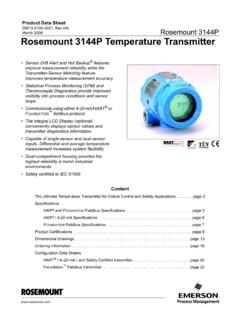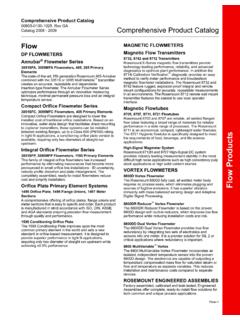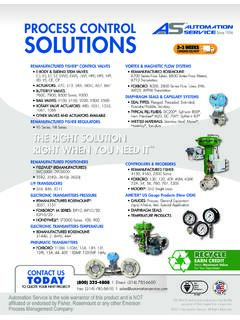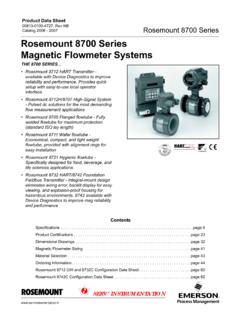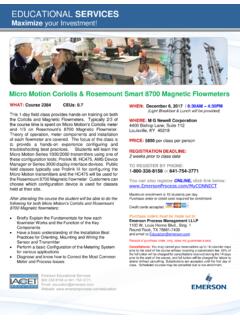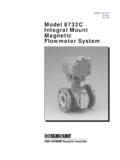Transcription of Rosemount 8700 Series, Rosemount 8700 Series Magnetic ...
1 00825-0100-4725. Quick Installation Guide00825-0100-4727, Rev AAApril 2009 Rosemount 8700 SeriesStartStep 1: Pre-InstallationStep 2: HandlingStep 3: MountingStep 4: Installation (Flanged Sensors)(Wafer Sensors)(Sanitary Sensors)Step 5: GroundingStep 6: WiringStep 7: Basic ConfigurationEndRosemount 8700 Series Magnetic Flowmeter Page 1 Tuesday, April 28, 2009 2:14 PMQuick Installation Guide00825-0100-4727, Rev AAApril 2009 Rosemount 8700 Series2 2009 Rosemount Inc. All rights reserved. All marks property of NOTICEThis document provides basic installation guidelines for the Rosemount 8700 Series Sensors.
2 It does not provide instructions for detailed configuration, diagnostics, maintenance, service, troubleshooting, explosion-proof, flame-proof, or intrinsically safe ( ) installations. Refer to the Rosemount 8700 reference manual (document number 00809-0100-4727) for more instructions. The manual and this QIG are also available electronically on to follow these installation guidelines could result in death or serious injury:Installation and servicing instructions are for use by qualified personnel only. Do not perform any servicing other than that contained in the operating instructions, unless qualified.
3 Verify that the operating environment of the sensor and transmitter is consistent with the appropriate FM, CSA, ATEX, or IECEx sensor liner is vulnerable to handling damage. Never place anything through the sensor for the purpose of lifting or gaining leverage. Liner damage can render the sensor avoid possible damage to the sensor liner ends, do not use metallic or spiral-wound gaskets. If frequent removal is anticipated, take precautions to protect the liner ends. Short spool pieces attached to the sensor ends are often used for flange bolt tightening is crucial for proper sensor operation and life.
4 All bolts must be tightened in the proper sequence to the specified torque limits. Failure to observe these instructions could result in severe damage to the sensor lining and possible sensor Process ManagementRosemount Technology DriveEden Prairie, MN USA 55344T (US) (800) 999-9307T (Intnl) (952) 906-8888F (952) 949-7001 Emerson Process Management FlowNeonstraat 1 6718 WX EdeThe Netherlands T +31 (0)318 495555F +31(0) 318 495556 Emerson Process Management Asia Pacific Private Limited1 Pandan CrescentSingapore 128461T (65) 6777 8211F (65) 6777 0947/65 6777 0743 Emerson Box 17033 Jebel Ali Free ZoneDubai UAETel +971 4 811 8100 Fax +971 4 886 Page 2 Tuesday, April 28, 2009 2:14 PMQuick Installation Guide00825-0100-4727, Rev AAApril 2009 Rosemount 8700 Series3 STEP 1: HANDLINGH andle all parts carefully to prevent damage.
5 Whenever possible, transport the system to the installation site in the original shipping containers. PTFE-lined sensors are shipped with end covers that protect it from both mechanical damage and normal unrestrained distortion. Remove the end covers just before 2: MOUNTINGU pstream/Downstream PipingTo ensure specification accuracy over widely varying process conditions, install the sensor a minimum of five straight pipe diameters upstream and two pipe diameters downstream from the electrode plane (see Figure 2).Installations with reduced straight runs from 0 to five pipe diameters are possible. In reduced straight pipe run installations, performance will shift to as much as of rate.
6 Reported flow rates will still be highly 1. Rosemount 8705 Sensor Support for HandlingFigure 2. Upstream and Downstream Straight Pipe Diameters - through 4-in. Sensors6-in. and Larger Sensors5 Pipe Diameters2 Pipe Page 3 Tuesday, April 28, 2009 2:14 PMQuick Installation Guide00825-0100-4727, Rev AAApril 2009 Rosemount 8700 Series4 Flow DirectionThe sensor should be mounted so the FORWARD end of the flow arrow, shown on the sensor identification tag, points in the direction of flow through the OrientationThe sensor should be installed in a position that ensures the sensor remains full during operation.
7 Vertical installation allows upward process fluid flow and keeps the cross-sectional area full, regardless of flow rate. Horizontal installation should be restricted to low piping sections that are normally full. In these cases, orient the electrode plane to within 45 degrees of electrodes in the Rosemount 8705 sensor are properly orientated when the two measurement electrodes are in the 3 and 9 o clock positions, as shown on the right of Figure electrodes in the Rosemount 8711 are properly orientated when the top of the sensor is either vertical or horizontal, as shown in Figure 4. Avoid any mounting orientation that positions the top of the sensor at 45 from the vertical or horizontal 3.
8 Sensor Page 4 Tuesday, April 28, 2009 2:14 PMQuick Installation Guide00825-0100-4727, Rev AAApril 2009 Rosemount 8700 Series5 STEP 3: INSTALLATIONF langed SensorsGasketsThe sensor requires a gasket at each of its connections to adjacent devices or piping. The gasket material selected must be compatible with the process fluid and operating conditions. Metallic or spiral-wound gaskets can damage the liner. Gaskets are required on each side of a grounding ring. All other applications (including sensors with lining protectors or a grounding electrode) require only one gasket on each end connection. Flange BoltsNOTEDo not bolt one side at a time.
9 Tighten each side simultaneously. Example: 1. Snug left2. Snug right3. Tighten left4. Tighten rightDo not snug and tighten the upstream side and then snug and tighten the downstream side. Failure to alternate between the upstream and downstream flanges when tightening bolts may result in liner torque values by sensor line size and liner type are listed in Table 1 for ASME (ANSI) and Table 2 for DIN flanges. Consult the factory if the flange rating of the sensor is not listed. Tighten flange bolts on the upstream side of the sensor in the incremental sequence shown in Figure 5 to 20% of the suggested torque values.
10 Repeat the process on the downstream side of the sensor. For sensors with more or less flange bolts, tighten the bolts in a similar crosswise sequence. Repeat this entire tightening sequence at 40%, 60%, 80%, and 100% of the suggested torque values or until the leak between the process and sensor flanges stop. Figure 4. Rosemount 8711 Mounting Position45 Electrode Plane45 Electrode Page 5 Tuesday, April 28, 2009 2:14 PMQuick Installation Guide00825-0100-4727, Rev AAApril 2009 Rosemount 8700 Series6If leakage has not stopped at the suggested torque values, the bolts can be tightened in additional 10% increments until the joint stops leaking, or until the measured torque value reaches the maximum torque value of the bolts.




